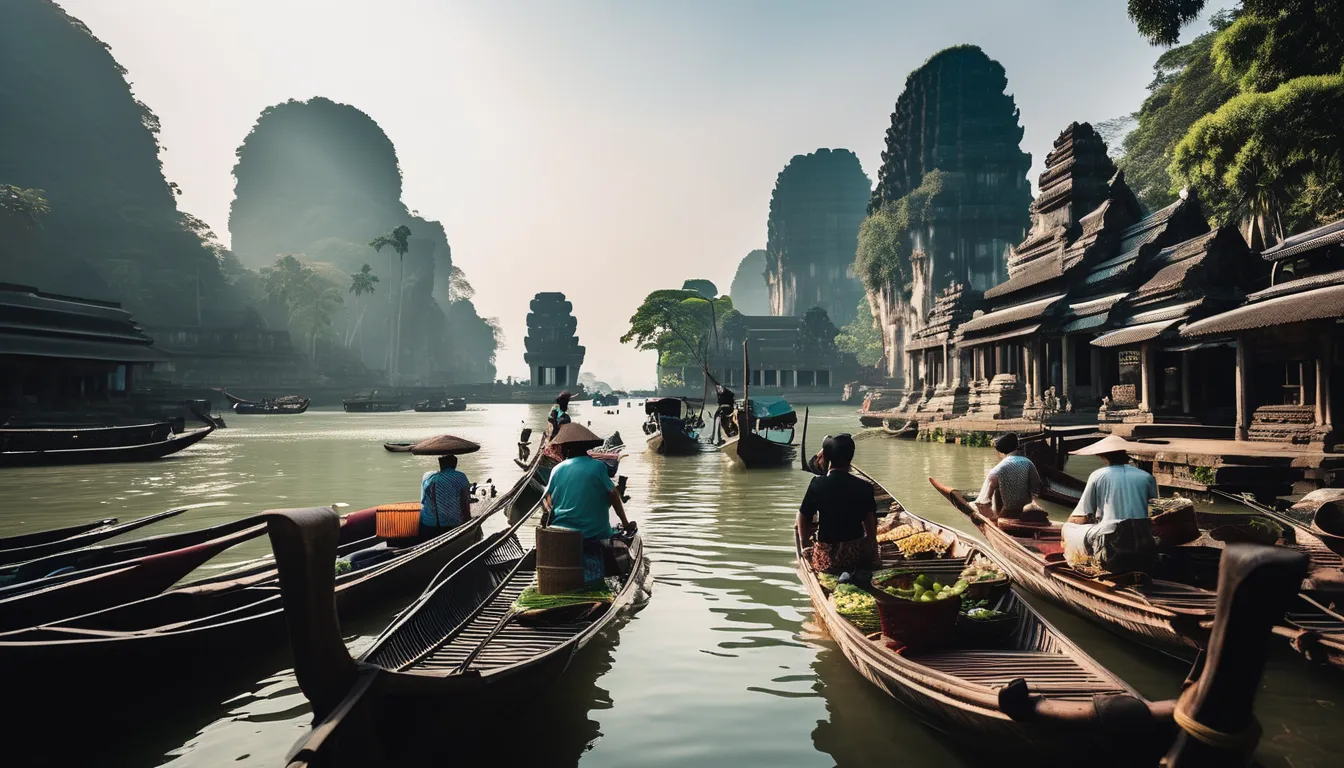For most travelers, this is a dream destination that Southeast Asia has been for ages. Rich culture, breathtaking landscapes, friendly locals, and pocket-friendly prices define this region, catering to all travelers – from backpackers to luxury hunters. For those who will want to explore ancient temples, where one lies down and swims along sun-kissed beaches, or perhaps trek through dense jungles, Southeast Asia indeed does it all. This is an all-inclusive travel guide, guiding you through the need to travel in Southeast Asia-from planning your trip and finding must-visit destinations.
1. Best Time to Visit Southeast Asia
Southeast Asia happens to be a tropical climate with dry and wet seasons across the board. The best time to visit would depend on the destination. However, in general, one prefers to come to Southeast Asia during its dry season, which is usually from November to March.
Dry Season (November to March) This is the hottest period during the dry season with intense sunlight and lesser humidity. This is the peak season when most of the visitors come to this place, especially to popular destinations like Thailand, Cambodia, and Vietnam.
Rainy Season (May to October): While heavy rain showers are indeed torrential, it is not all bleak. Rains come in bursts, and the countryside is alive and green. Travel during the rainy season is less crowded with a much lower cost, but you’ll be prepared for occasional disruption of outdoor activities.
2. Top Destinations in Southeast Asia
Southeast Asia includes some of the most incredible and well-known places in the world. Here’s a small selection of must-visit countries and cities:
Thailand: Throw beaches, cities, and history into a refreshing mix, and you’ll understand why Thailand is a destination to which travelers keep returning. Bangkok welcomes you with colorful streets, whereas you can visit ancient temples in Chiang Mai or relax on the islands of Phuket, Krabi, or Koh Samui.
Vietnam: This place is stunning, as it boasts fantastic landscapes, deep history, and delirious cuisine. Urban explorations are great in Hanoi and Ho Chi Minh City, while Phong Nha, Sapa, and Halong Bay offer nature and adventure.
Indonesia: With more than 17,000 islands, Indonesia is absolutely all-inclusive. It offers balneal and spiritual tourism-from beaches to temples like the magnificent Borobudur in Java. Don’t forget the unique landscapes of Lombok and the Komodo Island.
Cambodia: Amazing Angkor Wat, the largest religious monument in the world, is found there. The capital Phnom Penh is good for a visit with its history and culture.
Malaysia: Kuala Lumpur, cosmopolite cities, the beautiful beaches of Langkawi, cultural heritage of Penang are few attractions of Malaysia. Extensive rainforests and wildlife are spread all over the region of Borneo.
Laotian: Much more laid-back than its neighbors, Laos is poised with scenic beauty, waterfalls, and temples. Luang Prabang is a UNESCO World Heritage with Buddhist temples and colonial architecture.
3. Traveling Southeast Asia
The traveling in southeast Asia is pretty easy and budget-friendly, but the options change greatly from country to country. Here’s the overview of getting around:
Buses: It is pretty affordable to travel by bus in Southeast Asia, especially when traveling long-distance. Some countries like Thailand and Vietnam provide a number of bus lines many of which are public. Private bus operators also run in the same countries.
Trains: Trains exist both in Vietnam, Thailand, and Malaysia, but Vietnam and Thailand have better developed lines. Traveling by trains can indeed be very picturesque and comfortable at the same time. In Thailand, particularly, night trains from Bangkok go to Northern Thailand to other parts of the country.
Domestic Flights: Budget airlines such as AirAsia, VietJet, and Lion Air will offer you the cheapest travel options around Southeast Asia for longer distances. Booking in advance will save you a lot.
Tuk-Tuks and Motorbikes: Tuk-tuks are very popular within cities like Bangkok and Phnom Penh. A good variety of motorbikes are also available for renting and even taxi services through places like Vietnam.
Boats: The most common method of transportation to explore many islands in the region is ferry and speedboat. It is very widely used when traveling along the coastal areas.
4. Places to Stay in South East Asia
There are plenty of choices within the budget for travelers when staying in South East Asia, from a few dollars hostels and guesthouses to luxury resorts.
There are many hostels, guesthouses, and budget hotels, especially in any tourist hotspots. When it comes to dormitories, the price ranges from $5 to $15 per night in most hostels. For mid-range hotels, the prices go between $30 and $80 per night. The mid-range hotels tend to be roomier and more comfortable, having most amenities and convenience. There are many of them in the big cities and in tourist centers.
Luxury Resorts: Southeast Asia is certainly not short of luxury resorts, mostly in Bali, Phuket, and Langkawi. Prices there start from $100 to $500+ per night, with world-class amenities, private pools, and views that are right by the beach.
5. Food and Drink in Southeast Asia
Southeast Asia is a fantasy land for any food enthusiast, dishing up exotic dishes that bequeath the variety of cultures from the region. Street food is usually not only inexpensive but also savory and fun in which a traveler can involve local culture.
Thailand: Famous for its street food, Thailand offers dishes such as Pad Thai, Tom Yum Goong (spicy shrimp soup), and Som Tum (green papaya salad).
Vietnam: Vietnamese food is fresh and aromatic, with dishes such as Pho (noodle soup), Bánh Mì (sandwich), and Goi Cuon (spring rolls).
Indonesia: Indonesian cuisine differs from one region to another; however, they really liked Nasi Goreng (fried rice), Satay (grilled meat skewers), and Gado-Gado (vegetable salad with peanut sauce).
Malaysia: Malaysian cuisine is an extravaganza of Malay, Chinese, and Indian flavors. Try Nasi Lemak (coconut rice), Char Kway Teow (stir-fried noodles), and Roti Canai (flatbread).
Cambodia and Laos: In Cambodia, Amok (fish curry) make the cut, as Laap (minced meat salad) and sticky rice in Laos.
6. Safety and Health Tips for Southeast Asia
Southeast Asia is usually a very safe destination but take some precautions.
Be Healthy: Drink bottled water, avoid ice cubes, and wash your hands frequently. Due to the presence of malaria or dengue fever in some locations, precautionary vaccinations and mosquito repellent come handy.
Travel Insurance: Never forget to carry an all-encompassing insurance for travelling that includes health, accident, and cancelation issues. Since the medical facilities will be different from country to country, one should always have an insurance.
Personal Safety: Petty theft is likely, especially in tourist areas that are overcrowded, but the area in general is said to be safe. Be sure to keep valuables on you or in a safe place when in crowded areas. Refrain from traveling alone at night within unfamiliar territories.
7. Cultural Norms
Once more, each country of Southeast Asia has their practice, so be sensitive to local norms.
Dress modestly: When visiting temples or religious sites, make sure to dress modestly with your shoulders covered as well as your knees. There are also some countries where it is typical to remove your shoes before entering a house and a temple.
Respect local traditions: Shows reverence towards the elders, monks, and religious symbols in countries such as Thailand, Cambodia, and Laos. At all times you are supposed to meet people with a smile and a gesture of respect, such as the traditional ‘wai’ of Thailand.
Bargaining: This is common when selling in markets and to tuk-tuk drivers; just be polite, however in every negotiation. Plan to accept a fair price that both can live with.
Conclusion
There is always adventure in Southeast Asia, and in the world of leisure and cultural discovery. It can definitely be much more than fully enjoyed if little foresight, flexibility, and an open mind are applied in time during your trip there. From the boisterous streets of Bangkok, richly alive with life, to the peaceful beaches of Bali, Southeast Asia is home to all worlds and has everything to offer travelers. Pack your bags, book your flights, and get ready to take off on the journey of a lifetime!







